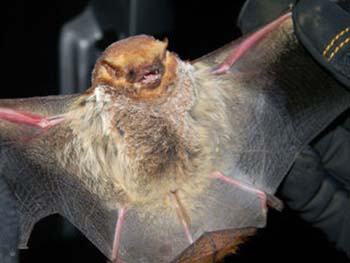(703) 881-3170
Seminole Bat Information
Seminole Bat Facts

The Seminole Bat is a rare bat that can be found in southeastern Virginia. Just like the Northern Yellow Bat, the Seminole bat is dependent on Spanish moss which grows near the ocean. Due to it being so rare, there isn't a conservation status for this bat. However, there are some conservation concerns regardles. The removal or damaging of areas with Spanish moss reduces the places this bat can rear young causing them to either die or leave Virginia altogether. This bat does not like to roost on man-made objects, but prefers Spanish moss. The odds of this bat being in your home, along with their small number in Virginia makes it very unlikely for it to be in your home.
Seminole Bat Characteristics
The Seminole Bat is often confused with the Eastern Red Bat, however, instead of a red fur color it has a mahogany color with frosted tips that give it a frosted look. Another way to distinguish it from the Eastern Red Bat is that it has white patches of fur on its shoulders and wrists. The Seminole Bat is between 3.5-5 inches in length with a wingspan of 11 to 13 inches.
Seminole Bat Mating and Breeding
Mating occurs during the fall, and it is not certain if these bats have delayed fertilization where they will mate and then delay getting pregnant until the winter. Birthing occurs in late May to early June, where they will raise young in Spanish Moss.
Seminole Bat Diet
The Seminole bat hunts at dusk in open areas such as golf courses, or areas above the trees. Seminole Bats are also seen near areas of light where insects gather at night. They primarily hunt by echolocation. They feast on flies, beetles, bees, wasps, and crickets.
